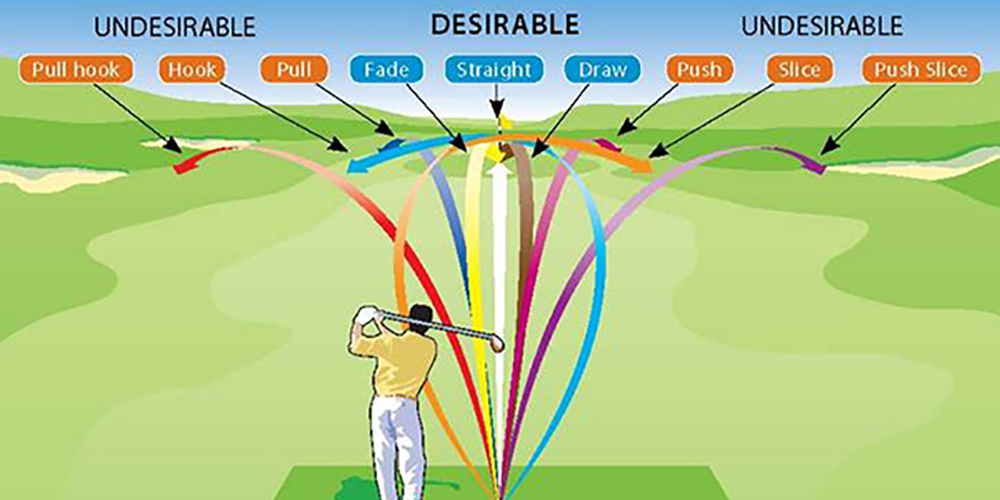Slice Vs Hook | The Difference and Tips for Fixing Each
What's the difference between a slice vs a hook? What causes these errant golf shots? And how do you fix them?
We've answered all of these questions below!
What is a Slice in Golf?
A "Slice" is a golf shot shape where the ball curves sharply to the right for a right-handed golfer (or curves to the left for a left-handed golfer).
Unlike a "Fade," an often desirable slightly left-to-right shot shape, a slice curves too much, typically resulting in misses far to the right. Not only is a slice likely to curve too much to keep in play, but you'll also lose distance hitting a slice.
Slices are caused by hitting the ball with an open (aimed right) clubface relative to your swing path. An outside-to-inside swing path often exacerbates this problem.
If your shot starts right but moves in a straight line, this is a push rather than a slice. One of the worst golf shots is a combination of a slice and a push (push slice) where you both start the ball right and spin the ball to the right.

What is a Hook in Golf?
A "Hook" is a golf shot shape where the ball curves sharply to the left for a right-handed golfer (or curves to the right for a left-handed golfer).
Hooked shots will miss your target to the left. You'll also lose distance compared to a straighter shot as the ball flies more sideways rather than forward.
The cause of a hooked golf shot is the clubface being closed (aimed left) of your swing path. An overly inside-to-outside swing can make a hook worse.
A shot that moves straight to the left is a pull rather than a hook. Like a push slice, a pull hook is one of the worst shots in golf. A pull hook both starts left curves further to the left.
Slice vs Hook
Slices and Hooks are both golf shots that curve too much sideways. The difference when comparing a slice vs a hook is the direction that the shot curves.
For a right-handed golfer, a slice curves too much to the right. A hook curves too much to the left.
Fixing Slices and Hooks: Revisit Fundamentals Including Grip, Setup, and Takeaway
While a slice or hook can be caused by problems in your swing, fixing your grip, ball position, setup, and takeaway is often the solution to these problems or at least alleviates them significantly.
We'd recommend revisiting these fundamentals if you're struggling with a slice or hook.
Grip
Too weak or too strong of a grip often leads to delivering a clubface that's too open or closed at impact. In general, we find that it's more common for struggling golfers to have a grip that's too weak rather than too strong.
Regardless, we always recommend that struggling golfers start with the grip. It's the easiest thing to fix in golf, yet it can have a drastic effect on your ball striking.
In particular, we'd recommend starting from scratch, aiming for a relatively neutral grip.
The video by Athletic Motion Golf below will teach you how to make a perfect grip every time.
Throughout this guide, we'll be including a lot of Athletic Golf Motion videos. We're not affiliated with them, we've just found their channel to have the best free golf tutorials on YouTube.
They've gained insights into the golf swing and setup by analyzing top PGA Tour professionals in Gears 3D motion capture.
Setup and Ball Position
Slices and hooks can also be caused or worsened by incorrect setup and ball position. While this is slightly more complicated to fix than your grip, it's still a lot easier to fix than issues during your backswing or downswing.
We'd recommend checking out Athletic Motion Golf's video on golf setup and addressing the ball. It includes 3D motion capture of a multiple-time PGA Tour winner's setup.
The guys at Athletic Motion Golf touch on ball position in the above video, but you may want to check out the following video for a deeper dive on this topic.
Takeaway
If you're still struggling with a slice after correcting your grip and setup to the ball, you're almost certainly making mistakes with face control and/or swinging too much out-to-in on the ball.
Flaws in your backswing lead to problems in your downswing.
The takeaway (backswing to club parallel) is a great checkpoint to make sure your swing is getting off to a good start. That's why you'll see so many PGA Tour professionals, like Justin Thomas, rehearse their takeaway just before making their swing.
 3 PGA Professionals Takeaways - Source: Athletic Motion Golf YouTube Channel
3 PGA Professionals Takeaways - Source: Athletic Motion Golf YouTube Channel
Two particular goals in the takeaway are staying on plane and having the clubface angle roughly the same angle as your spine when the club is parallel to the ground.
If the clubface is pointed more towards the sky (open) or ground (closed) at this point, you'll either be delivering the face the same way or subconsciously be trying to compensate for this during the downswing.
Again, Athletic Motion Golf has a great video on the takeaway, complete with 3D motion capture from top PGA Tour professionals.
